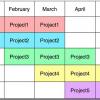|
Dissecting the Product Owner Role Like "coach" and "ScrumMaster," "product owner" is a new term for a new role. While coach and ScrumMaster are completely new roles added by agile methods, the product owner is an extension of an existing role—or rather, it is an extension to two existing roles. Whatever the role is called, it is concerned with deciding what should be in the next iteration, prioritizing work, providing guidance on what is being built, and ensuring value is created. |
||
|
Pair Programming - Is it just pushing up developer rates and doubling demand? Is it just pushing up developer rates and doubling demand? The cynic in me applauds the genius of the global developer community for inventing a way of working that requires twice the number of people to do the same amount of work – Pair Programming. Doubling demand on XP projects means more work for developers and reduces the pool available for traditional projects – rates go up and more jobs are secured. Is this the same genius as those 70’s marketing execs that added “step 3 - repeat” to double shampoo consumption and therefore sales overnight or are there genuine productivity gains to be had for consultancies and customers? I said I was being cynical, but there is some truth in this and it is a view held by some of those that pay the bills, customers. |
||
|
Mining Scrum: Modeling the Earth One Iteration at a Time Scrum Tapped for Mining Industry Mankind has, and always will try to understand its environment. In the last century, radar technology has allowed individuals to track vehicles, ships, planes, and even space shuttles and stars. With advances in sonar, people now have the ability to imagine a journey to space, or explore the mysteries of the sea. With the right scientific equipment, scientists can even witness new life and see it evolve. In the mining industry, the ability to identify and assess the world of solids is paramount. |
||
|
An Agile Approach to Retail: A Data-Intrinsic Development Case Study Agile software development challenges traditional software development approaches. Rapidly changing environments characterized by evolving requirements and tight schedules require software developers to take an agile approach. These methods include practices such as short iterations, frequent releases, simple and emerging design, peer review, and on-site customer participation. |
||
|
What's More Important: Being Agile or Creating Value? In this video, Jonathan Kohl looks at why and for whom we develop software, what our end users and team members value, and the difference between tools and processes that create value and those that distract from it. |
||
|
Performing the Software: Succeeding at Agile Development Sometimes, it's helpful to explore how people in other occupations create their products in order for us to better our own. In addition to being an experienced software tester, Chris McMahon has spent time on the road and in the studio as a professional musician. In this article, Chris takes a look at some of the things that make for a successful live concert and compares them to what it takes for an agile team to build software successfully. |
||
 |
No: Such a Difficult Word When people begin to get overworked, it's common to fall back on blaming the old chestnut "time management." But the problem may have less to do with how you allocate time to projects than your inability to say no to some of those projects in the first place. In this article, Johanna Rothman takes a look at the difficulty of saying no and offers some suggestions for overcoming it. |
|
|
Tips and Advice - Continuous Integration
Podcast
Tips and Advice - Continuous Integration |
||
|
How Agile Practices Reduce Requirements Risks Requirements risks are among the most insidious risks threatening software projects. Whether it is having unclear requirements, lack of customer involvement in requirements development, or defective requirements, these troubles are a major culprit in projects that go awry. As requirements expert and agile coach Ellen Gottesdiener explains, agile practice can go a long way in mitigating those risks. |
||
|
Agile 2009 - Conference preview with Johanna Rothman
Podcast
Bob Payne chats with Johanna Rothman about the upcoming Agile 2009 conference. |
Pages
Upcoming Events
| Jun 02 |
AI Con USA Bridging Minds and Machines |
| Sep 22 |
STARWEST Software Testing Conference in Anaheim & Online |
| Oct 13 |
Agile + DevOps USA The Conference for Agile and DevOps Professionals |










